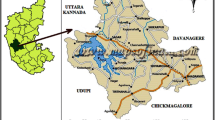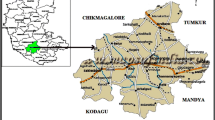Abstract
Radon in potable water increases the absorbable dosage by digestive and respiratory systems. Radon concentration was in the range of 0.92–17.12 Bq L−1. The maximum total effective dose of lung and stomach was 168.11 µSv y−1 for adults. As much as 0.25% of the population in this area is exposed to high dose of radon. Therefore, aeration of potable water in these regions is recommended before consumption.




Similar content being viewed by others
References
United Nations Scientific Committee on the Effects of Atomic Radiation UNSCEAR 2008 Report to the General Assembly with Scientific Annexes
Kaur M, Tripathi P, Choudary I et al (2017) Assessment of annual effective dose due to inhalation and ingestion of radon in water samples from some regions of Punjab, India. Int J Pure Appl Phys 13:193–200
Abbasnezhad A (2003) Environmental impacts and implications of the radon-222, and it’s urgency attention in Iran. Iran J Sci Technol 12:17–31
United Nations Scientific Committee on the Effects of Atomic Radiation UNSCEAR (2000) Sources and effects of ionizing radiation. New York
Malakootian M, Khashi Z, Iranmanesh F et al (2014) Radon concentration in drinking water in villages nearby Rafsanjan fault and evaluation the annual effective dose. J Radioanal Nucl Chem 302:1167–1176
Tansi C, Tallarico A, Iovine G et al (2005) Interpretation of radon anomalies in seismotectonic and tectonic-gravitational settings: the south-eastern Crati graben (Northern Calabria, Italy). Tectonophysics 396:181–193
Al-Tamimi M, Abumurad K (2001) Radon anomalies along faults in North of Jordan. J Radiat Meas 34:397–400
De Guarrini F, Vascotto M (2000) A radon survey in kindergartens of Trieste and Gorizia districts (North East of Italy). Int J Med Biol Environ 28:115–122
Baykara O, Dogru M (2006) Measurements of radon and uranium concentration in water and soil samples from East Anatolian Active Fault Systems (Turkey). J Radiat Meas 41:362–367
Aydin MF, Söǧüt O (2019) Measurement of radon gas activity concentrations in drinking water in the city center of Adıyaman, Turkey. J Radiat Prot Environ 42:10–14
WHO Handbook on Indoor Radon 2009 a Public Health Perspective—edited by Hajo Zeeb, and Ferid Shannoun. Photo cover: ©Swiss Federal Office of Public Health Design and layout: Patrick Tissot/WHO, pp 3–20
Martins L, Pereira A, Oliveira A et al (2019) A new framework for the management and radiological protection of groundwater resources: the implementation of a portuguese action plan for radon in drinking water and impacts on human health. Water 11(4):760
Duggal V, Sharma S, Mehra R (2017) Radon levels in drinking water of Fatehabad district of Haryana, India. Appl Radiat Isot 123:36–40
Erees F, Aytas S, Sac M et al (2007) Radon concentrations in thermal waters related to seismic events along faults in the Denizli Basin, Western Turkey. J Radiat Meas 42:80–86
Ayvazian LF (1988) Health risks of radon and other internally deposited alpha-emitters (Beir IV). American Lung Association, Chicago
Mittal S, Rani A, Mehra R (2016) Estimation of radon concentration in soil and groundwater samples of Northern Rajasthan, India. J Radiat Res Appl Sci 9:125–130
Pirsaheb M, Najafi F, Khosravi T et al (2013) A systematic review of radon investigations related to public exposure in Iran. Iran Red Crescent Med J 15:26–33
Duggal V, Mehra R, Rani A (2013) Determination of 222Rn level in groundwater using a RAD7 detector in the Bathinda district of Punjab, India. Radiat Prot Dosimetry 156:239–245
Erdogan M, Eren N, Demirel S et al (2013) Determination of radon concentration levels in well water in Konya, Turkey. Radiat Prot Dosimetry 156:489–494
Malakootian M, Darabi Fard Z, Rahimi M (2015) Determination of radon concentration in drinking water resources of villages nearby Lalehzar fault and evaluation the annual effective dose. J Radioanal Nucl Chem 304:805–815
Guidelines for third edition recommendations drinking-water qualit (2008) World Health Organization, Geneva, vol 1
Khattak N, Khan M, Shah M et al (2011) Radon concentration in drinking water sources of the Main Campus of the University of Peshawar and surrounding areas, Khyber Pakhtunkhwa, Pakistan. J Radioanal Nucl Chem 290:493–505
Gso I (1959) Cartographer geological map of Iran sheets 7545–7547 [Geology].State library of geology survey and mineral exploration (management Kerman), Iran
Radiation, U.N.S.C.o.t.E.o.A. (2000) Sources and effects of ionizing radiation: sources, vol 1. United Nations Publications
Moldovan M, Constantin Niţă D, Cucos-Dinu A et al (2013) Radon concentration in drinking water and supplementary exposure in Băiţa-Ştei mining area, Bihor county (Romania). Radiat Prot Dosimetry 158:447–452
Todorovic N, Nikolov J, Forkapic S et al (2012) Public exposure to radon in drinking water in Serbia. Appl Radiat Isot 70:543–549
Asadi A, Rahimi M (2013) Determination of the annual effective dose absorbed by the people of Rafsanjan City and surrounding areas with measurement of radon gas concentration in drinking water using active method. In: Iran conference paper 2013
Somashekar R, Ravikumar P (2010) Radon concentration in groundwater of Varahi and Markandeya river basins, Karnataka State, India. J Radioanal Nucl Chem 285:343–351
Han Y, Kuo M, Fan K et al (2006) Radon distribution in groundwater of Taiwan. Hydrogeol J 14:173–179
Mazlomi A, Bajestani A. Evaluating the origin, environmental impacts and measurement of radon gas in the water resources of the infant fault zone in South Khorasan. In: The 1st national conference on environment, energy and biodefense 1392. Department of Geology, Message Noor University, Postal Code 9763- 59391, Tehran, Iran
Malakootian M, Salmani MH (2015) Determination of radon level in drinking water in Mehriz villages and evaluation the annual effective absorbed dose. Int J Radiat Res 3:253–260
Malakootian M, Soltani NY (2017) Determination of radon concentration in drinking water of Bam villages and evaluation of the annual effective dose. Int J Radiat Res 15:81
Malakootian M, Marvast H (2016) Determination of radon concentration in drinking water of Taft Township and evaluation of the annual effective dose. Int J Radiat Res 14:39–46
Acknowledgements
This research was conducted at the Environmental Health Engineering Research Center and was sponsored by the Vice-Chancellor for Research and Technology of Kerman University of Medical Sciences.
Author information
Authors and Affiliations
Corresponding author
Additional information
Publisher's Note
Springer Nature remains neutral with regard to jurisdictional claims in published maps and institutional affiliations.
Rights and permissions
About this article
Cite this article
Shamsaddini, M., Negarestani, A., Malakootian, M. et al. Study of radon concentration of drinking water sources in adjacent areas of Sabzevaran fault. J Radioanal Nucl Chem 326, 1437–1446 (2020). https://doi.org/10.1007/s10967-020-07426-9
Received:
Accepted:
Published:
Issue Date:
DOI: https://doi.org/10.1007/s10967-020-07426-9




